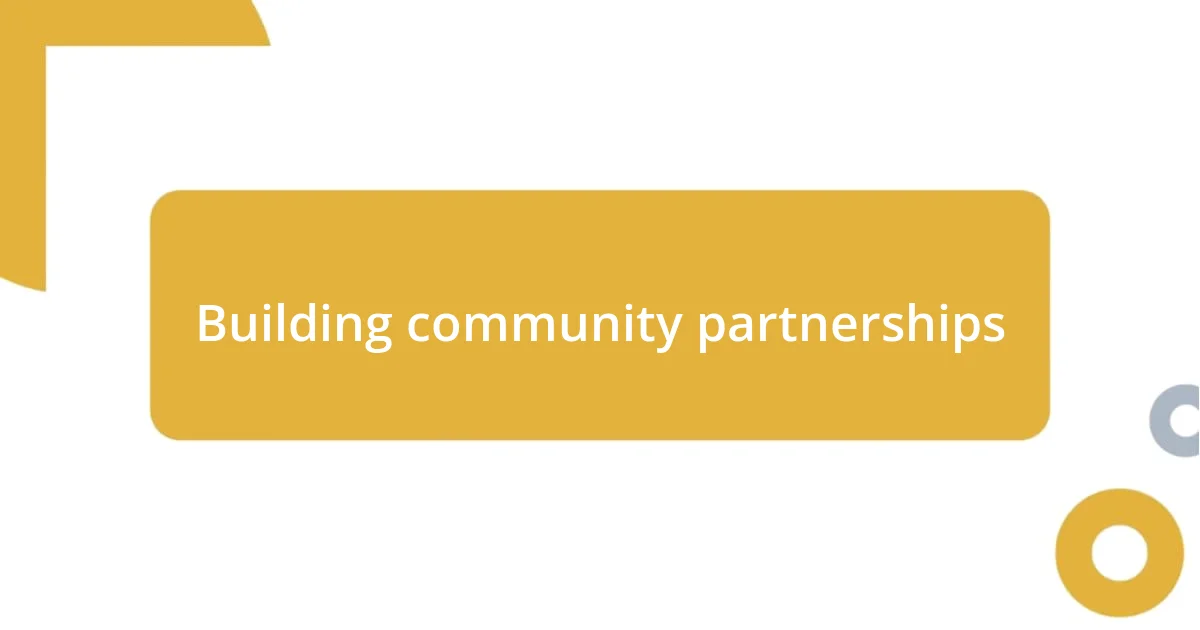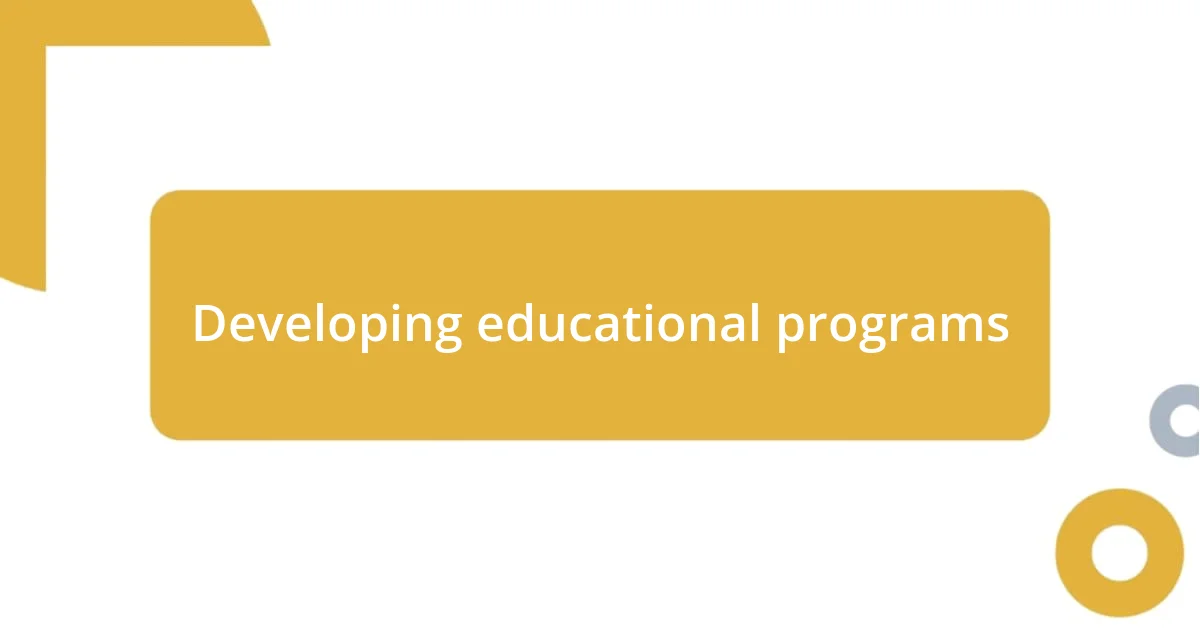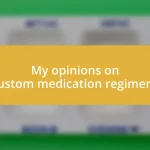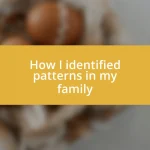Key takeaways:
- Equitable genetics advocates for equal access to genetic research and healthcare, emphasizing the importance of education and resources for underserved communities.
- Advocacy is crucial in empowering marginalized voices and addressing disparities in genetic testing across different socio-economic and geographic backgrounds.
- Measuring advocacy impacts involves assessing community engagement, personal success stories, and systemic changes resulting from advocacy efforts in genetics.

Understanding equitable genetics
Equitable genetics is rooted in the idea that everyone, regardless of their background, should have equal access to genetic research and healthcare. I often find myself reflecting on the disparities I’ve seen in my own community, where individuals facing genetic diseases often lack the support and resources needed for proper diagnosis and treatment. How can we truly consider ourselves a progressive society if access to genetic information remains unevenly distributed?
When I think about the implications of equitable genetics, I envision a world where genetic advancements are not a privilege reserved for the wealthy but a common resource available to all. Several years ago, I worked on a project that aimed to bring genetic counseling to underserved neighborhoods. The gratitude from families when they finally understood their genetic risks was incredibly moving—it was a powerful reminder of how education and access can change lives. Does anyone deserve to be left in the dark about their health because of where they live or their financial situation?
The emotional weight of equitable genetics lies in its potential to foster community health and resilience. I’ve seen how sharing genetic information can create bonds among people facing similar challenges, allowing them to support one another. If we prioritize equitable access to genetics, we’re not just advocating for science but for the dignity and health of every single individual. Isn’t that a goal worth striving for?

Importance of advocacy
Advocacy plays a crucial role in shaping our understanding and implementation of equitable genetics. I remember attending a conference where a speaker shared an eye-opening statistic: genetic testing is often more accessible in affluent urban areas than in rural communities. This reality struck me deeply. Advocacy bridges these gaps by raising awareness and pushing for policies that ensure everyone can benefit from genetic advancements, regardless of their socio-economic status.
Moreover, advocacy can empower marginalized voices in the genetic landscape. During a community outreach program I organized, I heard heartbreaking stories from individuals unable to access necessary genetic testing. Their experiences underscored how crucial advocacy is in amplifying their needs. By advocating for equitable genetics, we’re not just talking about science; we’re championing the rights of people who often feel invisible in the healthcare system.
Finally, the impact of advocacy can ripple throughout society. When we work towards equitable genetics, we set the foundation for improved health outcomes across diverse populations. I once spoke with a mother who shared how understanding her child’s genetic condition changed the trajectory of their care. Her determination to spread awareness in her community is a testament to how advocating for change empowers others to share their stories and seek the care they deserve.
| Importance of Advocacy | Examples |
|---|---|
| Bridging Gaps | Awareness of unequal access to genetic testing |
| Empowering Voices | Sharing stories from marginalized individuals |
| Creating Ripples | Improved health outcomes and community impact |

Identifying key genetic disparities
Identifying genetic disparities involves observing patterns that reveal how societal factors impact health outcomes across different populations. I recall a moment at a genetic research symposium where a fellow researcher pointed out that individuals from minority backgrounds are significantly underrepresented in clinical trials. This lack of representation doesn’t just skew research results—it perpetuates health disparities that can affect lives in real, tangible ways.
- Underrepresentation in Trials: Minority groups often have limited participation in genetic research.
- Socioeconomic Barriers: Financial constraints affect access to genetic testing and counseling services.
- Geographic Inequities: Rural communities face challenges in accessing genetic specialists compared to urban counterparts.
I’ve seen firsthand what these disparities mean in practice. A close friend of mine, whose family comes from a marginalized background, struggled to access genetic testing due to both cost and availability in their area. Watching her navigate this frustrating process left me questioning how many others might be suffering in silence, unaware of potential genetic conditions that could be managed or treated effectively. These personal stories drive home the urgency of identifying and addressing key genetic disparities in our healthcare system.

Building community partnerships
Building community partnerships is an essential part of advocating for equitable genetics because it fosters collaboration and shared understanding. I remember a local health fair where I teamed up with community leaders and health professionals. Together we created a space where families could learn about genetic resources available to them. Seeing parents light up with hope after finding out about local genetic counseling services made me realize the profound impact such partnerships can have.
Building these connections is about so much more than sharing information; it’s about cultivating trust within communities that have historically been marginalized. I recall a poignant conversation with a community elder who had long been skeptical of genetic research. After opening up about her concerns, we were able to discuss the importance of representation in research. By actively listening and addressing fears, we transformed her skepticism into enthusiasm for participating in genetic studies. Isn’t it fascinating how a simple dialogue can change perspectives?
In establishing these partnerships, we often find that shared storytelling is a powerful tool. During a workshop, I invited individuals to share their genetic stories, creating a tapestry of experiences that highlighted both struggles and triumphs. One participant spoke about her journey to understand her family’s genetic history, and it was clear that these conversations inspired hope and a sense of belonging. Can you imagine how much healing can occur when people feel seen and heard in such a meaningful way? Building community partnerships not only informs but also unites us in our common goals.

Developing educational programs
When it comes to developing educational programs focused on equitable genetics, it’s crucial to tailor content that meets the specific needs of diverse communities. I remember volunteering with a nonprofit aimed at educating high school students about genetics. We developed hands-on workshops that not only explained genetic concepts but also incorporated real-life applications, like understanding family health history. Seeing those students light up when they could connect the dots to their own lives was truly rewarding; it drove home the importance of context in learning.
Creating engaging educational materials also means being mindful of language and cultural relevance. I once worked on a project where we translated genetic testing resources into multiple languages to reach non-English-speaking families. The enthusiasm we encountered was incredible; I still recall a mother who exclaimed, “Finally, this information is for us!” It reminded me that accessibility can be a game changer, empowering individuals to take charge of their health journeys. How often do we overlook the power of simply speaking someone’s language, both literally and figuratively?
Another vital element of these programs is fostering a safe environment for questions and discussions. During a community presentation, I encouraged attendees to share their experiences and concerns regarding genetic testing. One participant hesitated but ultimately shared her fears about the implications of knowing her genetic risk. That moment was a testament to the courage it takes to confront uncertainty. I realized that it’s not just about delivering information; it’s about nurturing a supportive atmosphere where knowledge can flourish—wouldn’t it be amazing if everyone felt comfortable voicing their concerns in health settings?

Engaging policymakers effectively
Engaging policymakers requires clarity and passion; after all, they’re the decision-makers who can amplify our voices. I remember a pivotal meeting with local representatives where I presented compelling data on health disparities in genetics. I framed it not just as a statistics issue but as a human one, sharing a story about a family who faced obstacles in accessing genetic resources. When I saw their expressions change, I realized that genuine connection often arises from personal narratives.
Building effective advocacy also means understanding the political landscape. Prior to a major legislative session, I took time to research the backgrounds and interests of key policymakers. By aligning my message with their agendas, I was able to present genetic equity as a vital public health issue they could champion. Imagine how much more impactful our efforts can be when we speak their language and highlight shared goals.
Finally, persistence is key in this advocacy effort. It often takes multiple discussions for policymakers to truly grasp the nuances of equitable genetics. I once spent months following up after an initial meeting, providing updated research and inviting them to community events. That dedication paid off when they eventually voiced support for a new initiative in genetics. Have you ever experienced that thrill when your perseverance turns into policy change? It’s rewarding to realize that every little effort contributes to a larger movement for equity.

Measuring advocacy impacts
Measuring the impact of advocacy in equitable genetics can sometimes feel like navigating a complex web. I recall collaborating with a research team to analyze the outcomes of our educational workshops; we gathered feedback through surveys and focus groups. Seeing the quantitative data backed by personal testimonials was enlightening—one participant’s newfound confidence in discussing genetic testing with family illustrated the real-world impact of our efforts. How often do we step back to evaluate not just the numbers but the stories behind them?
Another key metric is the shift in community engagement. I remember hosting a community fair where we offered free genetic screenings and consultations. The turnout was overwhelming, and many attendees shared that they had never felt comfortable approaching such topics before. Instances like this reminded me that it’s essential to look at who shows up. Are we reaching those who historically lack access to genetic information? That’s an important measure of success.
Finally, I’d argue that advocacy should also focus on the broader systemic changes it helps create. A few years ago, after connecting with local leaders, our coalition successfully lobbied for a grant to fund genetic education for underrepresented populations. This initiative not only improved access but also paved the way for more equitable health policies. Isn’t it fascinating how one ripple can lead to waves of change, reinforcing the notion that advocacy is a journey worth tracking?














